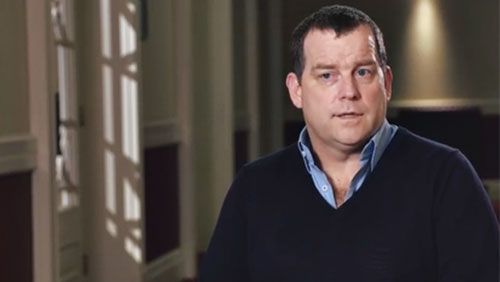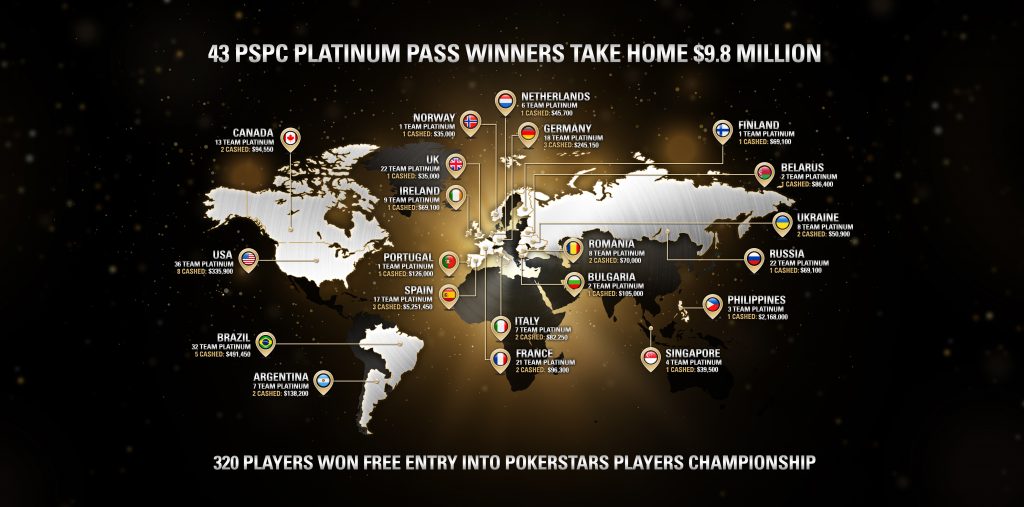Lee Davy sits down with Eric Hollreiser, Director of Poker Marketing for PokerStars, to hear his thoughts on the success of the PokerStars’ Player’s No-Limit Hold’em Championship, and to gauge whether the brand lives or dies.
 Up in the sky was a blood red moon shaped like a spade. It had dug a crater in the centre of the universe so big it forced you to watch. A black sky of a thousand eyes, this time, had 320.
Up in the sky was a blood red moon shaped like a spade. It had dug a crater in the centre of the universe so big it forced you to watch. A black sky of a thousand eyes, this time, had 320.
Twinkling.
Teasing.
Testing.
The PokerStars’ Player’s No-Limit Hold’em (PSPC) hit you with a punch that would crack a motorbike helmet. It stopped you in your tracks. It took everything we knew to be right about a poker tournament and blew it into the wind like a dandelion desperate to dance in the dandiest of discos.
320 people received a Platinum Pass worth $30,000.
Bibles.
Prayers.
Meditations.
Fingers crossed.
Ladders avoided.
Horses robbed of shoes.
A rabble of footless rabbits.
I looked around the poker room in the Atlantis and saw the same cardboard cutouts, only this time, frown lines had gone, replaced by smiles. Virgins sat next to them, but they didn’t look like virgins. What did it feel like for the person competing in a $25,000 buy-in event for the first time?
Love.
It must have felt like falling in love.
And how did it feel from inside the guts of this thing? How did the people who had spent 12-months trying to turn this day into Christmas, feel? Did they collapse through sheer exhaustion? Did they shave those legs, and begin to boogie? Did they smirk? Did they laugh? Did they cry?
I tracked down Eric Hollreiser, Director of Poker Marketing for PokerStars, to ask, and he was pleased to answer a few questions.
Was there a suite of metrics for the PSPC, what were they, and how did you fare against them?
“Well, I can say after-the-fact that our success metrics were “sweet,” laughs Hollreiser. “Metrics are the measurable outcomes of your goals, some of which are easily quantified some more subjective.
“Let’s look at what our goals were.
“We wanted:
– to tap into the core aspirations of people who play poker or we believe would be interested in playing poker. The most relevant example of this is Chris Moneymaker’s experience: a rags-to-riches path of an amateur poker player given the low-cost opportunity to compete amongst the best of the game and come away a champion with huge winnings.
– to generate a poker tournament that would be a must-attend event for the poker community.
– to create promotions and pathways that reach millions of people and are achievable enough for people to want to take the time and attention to try to qualify.
– to generate a consistent flow of stories through those promotions that captured people’s attention and enhanced the aspiration to participate.
– At the same time, to garner support for the people behind those stories so that we had relatable heroes to follow on their journey to provide a climax that brought all the stories, all the people and all the ambition to a natural conclusion. One that would – ideally – generate Moneymaker-like stories.
“The obvious quantifiable metric was a record-breaking attendance and prize pool that the PSPC generated. The more squishy metrics are around the buzz-building and positive brand building. I don’t have the full numbers just yet, but anecdotally it’s clear that we succeeded there given the huge buzz and positive feeling about PokerStars over a sustained period. So, I’m confident to say we fared pretty darn well.”
I would coco.
There was a time when the fountain in PokerStars Square pissed blood. The elephants have still not forgotten the sight. Over the past 12-months, champagne flowed. Poker turned into a celebration. Kazoos. Party Poppers. Candles lit and blown.
The decision to announce an event of this magnitude 12-months out, and to promise to go all Willy Wonka on the poker industry, by creating a brand within a brand, a platinum card, that turned poker players into wannabe writers, philanthropists, and vloggers, and writers, philanthropists, and vloggers into wannabe poker players produced a headline containing the word PokerStars daily for 365-days.
But what were the milestone moments for Hollreiser?
“Actually, there were at least 320 milestone moments as each Platinum Pass was awarded,” says Hollreiser. “By design, we captured every single story we possibly could and shared those experiences and stories throughout the course of 13 months.”
Come on lad.
Get it together.
13-months, not 12.
“ Also by design, we ensured that these were milestone moments in the lives of the people who won them,” Hollreiser said before continuing. “We discussed creating rock star moments and experiences for Platinum Pass players and for the most part we delivered. PokerStars Blog was a key platform and hub for many stories, and social and media built these up too. That created personalities out of some of the players.
“We created a Facebook group for holders of Platinum Pass winners, which quickly became an active community and gave them unfettered access to our Ambassadors and to members of the PokerStars team in an environment that helped the guys get to know one another before meeting at the event. We helped to create a special moment in time for many that most will never forget!”
There are those that still feel there is much work to be done. People not as easily swayed as me. A pantheon of poker players who still feel the thorns penetrating their person, while I stare on transfixed by the rose.
For the elephants in the room, let’s call this an excellent start.
So what next?
What future does Hollreiser want to see when it comes to PokerStars?
“A bright one that grows the audience for poker, delights our customers and allows us to provide even more opportunity for our employees and our players,” says the man from the Isle of Man. “We wake up every day looking for ways to create winning moments for players and expand the audience for poker. As long as we achieve that, we’ve been successful.”
Funny, I thought Hollreiser and his team woke up each morning, grabbed a coffee and a croissant, before sitting down in the War Room thinking of new ways to help their customers feel like the stuff we never look at before flushing away.
What are these winning moments for players, and how do they intend to expand the audience for poker?
“One key lesson has been to tap into the full passion of the company by asking for and taking input from anyone who has a positive idea for growing poker,” says Hollreiser. “In the awarding of Platinum Passes and executing our campaigns, we took ideas and help from practically every department in the company right up to the executive suite.
“Another key lesson was to take calculated risks in our marketing. We manage our brand very, very carefully – we always will. Consumers and influencers have unprecedented power and global platforms to engage with your brand in ways that you cannot control. That can be frightening, because by its very nature you cannot know, predict or control what the community will do and say about your brand.
“So, it’s critical to invest in being a part of the dialogue and stimulate the conversation about your brand with ideas, promotions and thoughts that give consumers reason to engage positively with you and amongst themselves. You need to have the confidence in your product, in your people and in their values to frequently engage with your fans, your customers and your critics.
“We did that in some truly innovative ways over the past year while seeking ways to engage audiences with Platinum Passes and the PSPC. Some were hugely successful, others less-so. But we’re looking at everything we did (and some things we didn’t get a chance to do) and will apply those findings to all that we do to promote and grow poker in 2019 and beyond.”
You can’t change a mind without first changing a heart, and without banging on about it like a 15-minute rendition of I am The Walrus, how central was this thought in the design of the PSPC?
“I’m not convinced that a brand’s primary goal should ever be to directly change someone’s mind,” says Hollreiser. “That’s not how most consumers choose who they do business with. The decision is usually based upon more emotional considerations. So, I think you’re right about it being about heart.
“If we focus on doing things that people love, that are relevant to their lives and aligned with their values, they’ll have a stronger connection with us. This usually leads to consumers having a higher opinion about the brand. Based upon the opinions we’ve heard about Platinum Passes and the PSPC, we’ve been successful. If that “changes” people’s minds – great.”

A napkin marked by food and spit lies on the table.
The curtain has fallen on the opera.
The barber holds the mirror behind the head.
With the Platinum Pass becoming a brand, and the PSPC pulling more people out of the grave than a George A. Romero movie.
What next?
“I like to think of a brand as an embodiment of emotions,” says Hollreiser. “That is, the emotions that go into its creation and execution and the emotions it evokes from the people it touches. Great care and attention went into the creation of the PSPC and the Platinum Pass was designed to represent ambition, aspiration and a pathway. PSPC was a manifestation of the goal for poker players: a competition, a celebration of community and an opportunity to score life-enhancing experiences and/or life-changing prizes.
“Over the course of 13 months, our Platinum Pass giveaways captured the attention, the imagination and the aspirations of a gamut of audiences within the poker community (from novices to pros) and in the media. That generated the kind of buzz that naturally increases interest among more mainstream audiences, which was a key goal in our mission to expand the audience for poker.
“PSPC, as an event, served a somewhat different purpose. We’re an online company, but live events provide a tangible opportunity to experience the PokerStars brand. It’s an opportunity for our customers and fans to have a direct real-life experience with the people behind the brand and – just as important – an opportunity to compete, socialize and share experiences, sometimes in life-affirming and life-changing ways.
“You’re asking if these brands will continue to exist. The lifetime of a brand is mostly determined by the audience. If the emotion it evokes resonates with consumers and with the people who represent it then you’re tapping into an enduring energy. As we discussed, the PSPC and Platinum Passes seemed to really resonate. The response from players, media and employees has been tremendous and there’s no doubt we want to continue to replicate the core things that they achieved – creating stories, building buzz, driving aspiration and creating community. So, we’ll take some time to assess what worked and what didn’t. We’ll continue to talk to players to see if there’s desire to continue in the same or similar way we executed in 2018. What do you think Lee?”
I don’t think, Eric.
I’m a hack who sits behind a keyboard banging little black squares, who a few weeks ago went to bed thinking it was possible to play in a $25,000 buy-in event and win $5.1m, and I want the chance to do that again.





